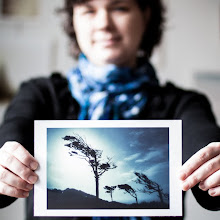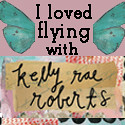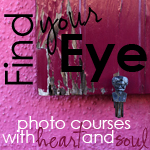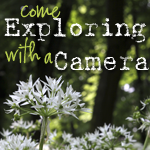Earlier this year, as I visited art museums in Madrid, I found myself drawn to paintings with two features: Interesting skies and rim light. When that happens, it's usually only a matter of time before these elements start showing up in my photography. We've already covered the sky as an Exploring with a Camera topic in Capture the Sky, so today we're going to complete my Madrid fascination and talk about subjects Rimmed with Light.
If a subject is rimmed with light, you get an effect of glowing edges of light outlining your subject. Rim lighting is a form of backlighting, but with the light source off to the side. In my recent study I've found it takes some specific conditions to capture rim light:
- Directional light. If there is even light, you won't have the strong light/dark contrast needed for rim light. You need directional light in order to get a strong contrast in light and shadow. The directional light doesn't have to be direct sunlight, it can be a lamp or a window in an otherwise unlit room.
- Angle of light source, subject and camera is important. To get rim light, the light source should be behind the subject but off at an angle. Low light works best, such as the sun in morning and evening, but is not always required. If the light is directly behind the subject, you will get a silhouette. If the light source is behind and only slightly off to the side of the subject, you can get rim light but you are at risk of lens flare (which you may or may not want). If the light is completely to the side of the subject, you get sidelight and will not have the "rim" effect.
- Contrasting Background. What's behind your subject matters, you need some contrast to really get the rim light to show brilliantly. The darker the background, the better the rim light will show up. A background in shadow works very well, as does converting images to black and white to highlight the get the tonal values and avoid color distractions.
- Exposure. The exposure you choose will effect how the rim light shows up and can significantly change the focal point of the image. For dramatic contrast with focus on the rim light, expose for the rim light with subject underexposed. To bring out more detail in the subject, overexpose the rim light.
I created this small diagram to clarify the requirements visually. The angle of light/subject/camera in this diagram is not scientifically determined (just to warn any of you engineers out there) it's just to give an idea to help you visualize the scenario that gives you rim light. This is a top view:
But, a picture is worth a thousand words, right? Let's look at some images...
This image of Stevie, my cat, is exposed to show the details highlighted by the rim light. I had all of the elements I needed to capture an image rimmed with light: sunlight coming through a window on the right, and a background in shadow. I put myself on the same level as the subject, and moved around left to right to experiment with the background that would give the best contrast while not losing the rim light. You can see how the light coming in the window curtains behind dramatically drops off and creates a dark background to contrast with the rim light. Converting this image to black and white helps keep the focus on the light and dark contrast and not the brightly colored blanket under Stevie.
This was one time that Stevie actually cooperated and sat still long enough for me to capture multiple images and study the lighting situation. Below are a couple of images straight out of the camera to show you the effect of exposure. In the first image, the exposure is set for the rim light, and Stevie's face is very underexposed. There is not enough rim light to highlight the full outline of his head, and he gets lost in the background.
1/64, f/4, 80mm, ISO400
In this next image, the exposure is set to get more detail in Stevie's face. I like this one with the detail better but the color of the blanket reflecting in his face is distracting to me. In my editing I would convert this to black and white to resolve that problem.
1/15, f/4, 80mm, ISO400
In studying rim light, it is good to move yourself around relative to the subject in order to see when the rim light appears/disappears and how it contrasts with the background. It is hard to do this type of study with moving subjects, so I've found statues can be a great way to learn.
I loved how the sculpture below, in the garden of the Rodin museum in Paris, is outlined with light. The hedge and trees behind created a good contrasting background that allows the rim light to stand out. It helps that the subject is a dark color, to further create contrast with the rim light. In this image, there is not only rim light created by the sunlight on the right, there is also sidelight in the reflected light coming from the pavement on the left. This light is more diffuse and serves to highlight the details in the statue subtly, without competing with the outline created by the rim light.
Another Rodin sculpture, the image below is indoors at the same museum. This was shot by looking toward a corner of a room. There is a window on the right wall, facing the direction of sunlight, and a window on the left wall, in the shade. Even though the sun is not shining directly on this statue through the window, you can see the effect of the directional light in creating rim light on the right, while the light is more diffused from the left and highlights more detail. The background is not dark, but there enough contrast for the rim light. Converting to black and white helped remove some color distraction of the background wall paneling.
One final sculpture image shows that the light does not always need to be low in the sky, it just needs to be directional and at an angle. For the image below, it was near noon and the sun was high in the sky, but since the buildings blocked most of the direct light, only one shaft fell on the statue in the Loggia in Florence and created the rim light.
Shafts of sunlight are great for creating rim light. This self portrait I captured in Venice is a good example of how a shaft of light can be used, along with the contrast of the other areas in shadow, to capture some rim light.
Hair, fur, etc. all seem to be great subjects for using rim light, since so many individual details can be highlighted by the light. They can also be difficult to capture, since subjects with hair and fur are usually in motion! This image of my son is from early in the morning in Florence looking at the Baptistry doors, next to the Duomo. I loved how the individual hairs on his head were outlined along with the features of his face.You might notice the flare, I was looking a bit more into the sun than was desired. Moving slightly to the right might have eliminated the flare, while still keeping the rim light. I will never know for sure though, because my son wasn't interested in keeping still that long for me to study him in this light. Again, I converted this image to black and white to highlight the light/dark tones and avoid color distractions from my son's clothing.
How about you? Have you been able to capture subjects rimmed with light? Look through your archive or go out seeking the rim light, and share your images here with us. You can link in below or add your images to the Flickr pool, or both. If you have any other tips for capturing subjects outlined in light, share those too! I look forward to learning from you.































What a fabulous post, Kat. It's stuffed with tips and your photographs are beautiful and illustrate your points brilliantly. My favourites are the first one of Stevie and the second Rodin sulpture (which takes first prize for me). They are really inspiring and remind me that I need to think a lot more about composition rather than just pointing the camera and shooting. Off now to try to find some rim light!
ReplyDeleteWonderful tutorial..and what amazing light. You've definitely mastered the 'art' of rim light!
ReplyDeleteA wonderful post again :) great advices and tips. I love them all.
ReplyDeleteHere, I go again, excitedly posting my entry for this theme. Hope you like it.
Have a great day :)
Beautiful photos Miss K! Love light more and more. Look for it, even chase it down.
ReplyDeleteThank you for such a great post! Your photos are beautiful! And your advice superb! I will now be playing with rim light. :)
ReplyDeleteWell, my bad for not reading this FIRST. It really would have helped with my capture! :) Next, next time.
ReplyDeleteThanks for the lesson! Love the first shot of kitty.
bugaboo, mini, mr & me
oh man i guess better next time for me, i found the post late..but great ttutorial
ReplyDelete